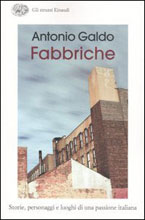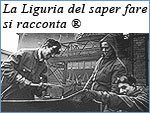|
|
|
 |
reviews |
 |
 |
 |
 |
 |
 |
 Fabbriche is an enjoyable read by journalist Antonio Galdo (director of L’Indipendente, a daily Italian newspaper) that provides a detailed account of places, people and events of Italy’s entrepreneurship, both past and present. The book opens with the glorious period of the founding fathers of the Italian industrial dynasties and brings the reader to the present large-scale reorganizations and closures. Fabbriche is an enjoyable read by journalist Antonio Galdo (director of L’Indipendente, a daily Italian newspaper) that provides a detailed account of places, people and events of Italy’s entrepreneurship, both past and present. The book opens with the glorious period of the founding fathers of the Italian industrial dynasties and brings the reader to the present large-scale reorganizations and closures.
Galdo begins in the first years of the twentieth century in the area surrounding Milan where the Pirelli Bicocca was founded. This factory settlement would become a large mixed urban industrial area with more than 20 thousand people (provided with staff canteens, social clubs and housing for employees). The project set many records: it was the first Italian company to be quoted on the Wall Street stock exchange and in 1908 Alberto Pirelli was the first Italian to travel by plane. Nowadays Pirelli’s heirs manage the real estate colossus Pirelli Real Estate with corporate assets of 600 million euros as well as the land where the Bicocca was built, which has become a center for numerous services--multiplexes, restaurants, theater, universities, and the offices of large multinational companies.
The story continues with Giorgio Enrico Falck’s steel plants that transformed the countryside of Sesto San Giovanni into an industrial town, becoming the first private iron and steel industry. At present, in this area too, there is an ambitious project by the Genoese architect Renzo Piano to transform Sesto San Giovanni into a city of research and ideas. The redevelopment will be carried out in collaboration with many, including scientist Carlo Rubbia and filmmaker Ermanno Olmi (who will shoot a documentary here).
In Turin, we stop at the first Italian car factory built in Lingotto, according to the wishes of Senator Giovanni Agnelli. The plant was constructed on five floors with the test track on the top floor. Here, too, Renzo Piano designed and implemented an urban restructuring plan in 1986 with the establishment of the car engineering faculty, an exhibition area (where the annual International Book Fair takes place), an auditorium, a conference center, a picture gallery and the largest food-and-wine center in Europe (Eataly, Carpano area). Also in Turin, we move to the area of Borgo San Paolo where Battista Farina (who later became internationally known as Pininfarina), before setting up his coach building and automobile design workshop, visited Detroit and had the courage to refuse a job offer from Henry Ford himself!
The account then takes us to the popular motorcycle Vespa, produced by Piaggio in Pontedera. The Piaggio factory was set up following the Second World War and, in the 1960s, gave work to the half of Ponterdera’s 26 thousand inhabitants. Galdo points out a further case of the strong links between the town and its factory with his description of the steel plant at Terni established in 1884.
The food industry is included in this book with several notable examples, including Pietro Barilla, who built the largest pasta factory in the world in Pedrignano (Parma). Gennaro Fabbri, with his distillery in Borgo Panigale (Bologna) preserves his famous receipt for sciroppo d’amarena, a sort of sour-cherry drink, while Nardini set up the oldest grappa distillery in Bassano in the province of Vicenza.
The history of Count Marzotto and his textile factory in Valdagno coincides with that of his town, a real company town with 16 thousand employees. A social town (nursery schools, a rest home, schools, cinema, theater, sports ground and swimming pool) that was admired by Giuseppe Di Vittorio but whose historical memory was tarnished during the social struggles of1968 when workers pulled down the statue of Gaetano il Vecchio, the founder of the empire.
Another curious history is that of Pilade Riello who, starting as a humble turner in the Ansaldo workshops in Genoa, in the 1920s, chose to return to his home town of Legnago (in the province of Verona) where he set up the Riello factory producing gas oil burners for bread ovens and hot water heaters. Riello employed two thousand people.
Aristide Merloni is another historic representative of the entrepreneurial Catholic culture that was strongly linked to the agricultural origins of the area where he was born. It was here that the new sociological figure of the “metal-sharecropper” (half factory worker and half farm worker) was born. Galdo underlines that, even now, 70% of the workers of the Merloni factories (manufacturers of liquid gas cylinders and hot water heaters) in the Region Marche own a tractor.
Other factories, instead, are described as a blot on the landscape. Antonio Galdo reconstructs the history of Ilva (then Italsider) in Bagnoli and of the Petrolchimico in Porto Marghera. The last accounts of Galdo’s book are dedicated to “post-factory workers” and the protagonists of flexible, creative work who sometimes are able to stand out even at an international level.
|
 |
|
| |
|
 |
 |
review |
|
|
|
|
 |

